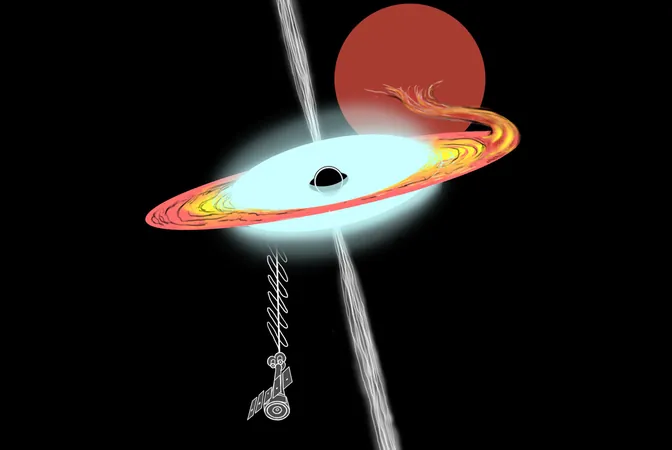
Unveiling the Secrets of a New Black Hole: NASA’s IXPE Provides Groundbreaking Insights!
2024-12-09
Author: Jacques
NASA’s IXPE and the New Black Hole
NASA's Imaging X-ray Polarimetry Explorer (IXPE) is leading the charge in unraveling the mysteries surrounding a newly discovered black hole—a stellar-mass black hole residing in the binary system Swift J1727.8-1613. This remarkable finding comes on the heels of an extraordinary brightening event in the summer of 2023 that allowed the black hole to momentarily surpass nearly all other X-ray sources in the sky.
Exploring the Accretion Disk and Corona
The IXPE mission offers a never-before-seen glimpse into the shapes and structures surrounding black holes, particularly focusing on the accretion disk—a swirling mass of material—and the hot plasma region known as the corona. Swift J1727 is the first black hole of its kind to be thoroughly observed by IXPE as it transitions through various phases of an X-ray outburst, marking a monumental step in our understanding of black hole X-ray binary systems.
Astrophysicist Insights
Astrophysicist Alexandra Veledina from the University of Turku, Finland, expressed her excitement about this unprecedented observation. "The rapid evolution of this outburst was astonishing. From our initial detection to its peak, the changes occurred in mere days. Observing the entire cycle—from brightness to inactivity—was exhilarating."
Intensity of the Outburst
Until late 2023, Swift J1727 shone brighter than the legendary Crab Nebula, a standard reference point for measuring X-ray brightness. While outbursts are not uncommon in binary star systems, the intensity of this event, combined with its proximity—merely 8,800 light-years away—makes it exceptionally noteworthy. The outburst was first detected on August 24, 2023, by the Swift Gamma-ray Burst Mission, which has been instrumental in identifying and cataloging cosmic phenomena.
The Nature of Binary Systems
Binary systems like Swift J1727 typically consist of two stars at different lifecycle stages, with the more massive star ultimately becoming a supernova. The remnants can include a neutron star, white dwarf, or black hole. In this case, the black hole's immense gravitational pull stripped material from its companion star, heating it to an astonishing 1.8 million degrees Fahrenheit, which in turn produced a torrent of X-rays. This process leads to the formation of an accretion disk and can generate a superheated corona around the black hole.
IXPE's Unique Capabilities
Using its unique capabilities, IXPE specializes in X-ray polarization—studying the direction of light to map the structure of these powerful cosmic entities. "Because light can't escape their gravity, we don't see black holes directly. Instead, we analyze what's happening around them, and IXPE is key in this ongoing research," noted Veledina.
Research Findings
Recent studies affiliated with IXPE concentrated on the early phases of the Swift J1727 outburst, led by Veledina and Adam Ingram from Newcastle University. They found that during the initial bright phases, the corona emerged as the main X-ray radiation source. Additionally, IXPE recorded polarized X-ray radiation following the black hole jet's trajectory, amplifying our understanding of the accretion disk's geometry.
Later States Studied
Intriguingly, researchers Jiří Svoboda and Jakub Podgorný from the Czech Academy of Sciences studied the changes in polarization during the later energetic state following the outburst. Their findings indicate that the geometric structure of the corona remained largely unchanged despite fluctuations in brightness, highlighting the complex yet stable nature of these cosmic systems.
Pivotal Moment in Astrophysics
These groundbreaking studies represent a pivotal moment in astrophysics, providing a clearer picture of the dynamics at play around black holes. With IXPE's capabilities as a tool for monitoring rapid changes in cosmic phenomena, the potential for future collaboration with other observatories is immense.
The Future of Black Hole Research
As Michal Dvořák, co-author of the studies, emphasized, "Observing multiple states of Swift J1727 is the ideal beginning to a new era in our comprehension of black holes." This ongoing research opens the door for further investigations into the nature and behavior of matter in proximity to black holes, paving the way for future discoveries that could redefine our understanding of the cosmos.
Conclusion
Stay tuned, because the universe is full of surprises, and you won’t want to miss what IXPE reveals next!



 Brasil (PT)
Brasil (PT)
 Canada (EN)
Canada (EN)
 Chile (ES)
Chile (ES)
 Česko (CS)
Česko (CS)
 대한민국 (KO)
대한민국 (KO)
 España (ES)
España (ES)
 France (FR)
France (FR)
 Hong Kong (EN)
Hong Kong (EN)
 Italia (IT)
Italia (IT)
 日本 (JA)
日本 (JA)
 Magyarország (HU)
Magyarország (HU)
 Norge (NO)
Norge (NO)
 Polska (PL)
Polska (PL)
 Schweiz (DE)
Schweiz (DE)
 Singapore (EN)
Singapore (EN)
 Sverige (SV)
Sverige (SV)
 Suomi (FI)
Suomi (FI)
 Türkiye (TR)
Türkiye (TR)
 الإمارات العربية المتحدة (AR)
الإمارات العربية المتحدة (AR)